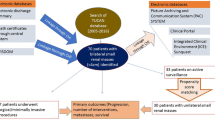Abstract
Purpose
To review the intermediate term oncologic and functional outcomes after the surgical management of bilateral renal masses (BRM).
Materials and methods
After obtaining Institutional Review Board approval, the Tulane renal surgery database (n = 890 patients) was queried for patients presenting with synchronous bilateral enhancing renal masses (n = 30 renal units). We performed a retrospective chart review evaluating oncologic and functional outcomes, specifically with respect to local recurrence and metastatic disease. We also reviewed changes in glomerular filtration rates.
Results
Of the 30 renal units were operated on for BRM concerning for renal cell carcinoma, 25 kidneys harbored malignancy (83.3 %). The average tumor size was 3.35 cm. Treatment of each kidney was staged; average time period to treatment of contralateral side was 3.5 months. Estimated GFR (eGFR) for these same pre-operative patients was 59 ml/min/1.73 m2 (range 25–89). The average creatinine after treatment of one kidney was available for all patients and was 1.5 (range 0.7–2.8), with an average eGFR of 51.8 (range 29–87). The average creatinine after the second operation for these same 15 patients was 1.79 (range 0.9–3.7) with an average GFR of 41.9 (range 17–78). No patient had to undergo temporary dialysis. An average change in GFR after the second, contralateral procedure on the kidney was 17.07 mg/dl. Average oncologic follow-up was 608 days. Excluding two patients who presented with metastatic disease, the average recurrence-free survival was 92.8 %.
Conclusion
Our data continue to underscore the need for nephron sparing surgery (NSS), especially in the setting of BRM. The average decline in GFR of 28.9 % after treatment of both kidneys and renal cell carcinoma recurrence-free rate of 92.3 % further support the efficacy of NSS in these patients.


Similar content being viewed by others
References
Chow WH (1999) Rising incidence of renal cell cancer in the United States. JAMA 281:1628–1631
Lowrance WT et al (2009) Developments in the surgical management of sporadic synchronous bilateral renal tumors. BJU Int 105:1093–1097
Marshall FF et al (1997) The national cancer data base: a report on kidney cancers. Cancer 80:2167–2174
Blute M et al (2003) The effect of bilaterality, pathological features, and surgical outcome in nonhereditary renal cell carcinoma. J Urol 179:1276–1281
Patel AR et al (2011) Bilateral synchronous tumors: pathologic concordance and clinical implications. Urology 78(5):1095–1099
Roos F et al (2011) Oncologic long-term outcome of elective nephron-sparing surgery versus radical nephrectomy in patients with renal cell carcinoma stage pT1b or greater in a matched-pair cohort. J Urol 77(4):803–808
Becker F et al (2006) Excellent long term cancer control with elective NSS for selected RCC’S measuring >4 cm. Eur Urol 49:1058–1064
Gill I et al (2007) Comparison of 1,800 laparoscopic and open partial nephrectomies for single renal tumors. J Urol 178(1):41–46
Huang HC (2006) Chronic kidney disease after nephrectomy in patients with renal cortical tumors: a retrospective cohort study. Lancet Oncol 7:735–740
Boorjan SA et al (2008) The impact of temporal presentation on clinical and pathological outcomes for patients with bilateral renal masses. Eur Urol 54:855–863
Cooperberg MR et al (2008) Decreasing size at diagnosis of stage 1 renal cell carcinoma: analysis from the National Cancer Data Base, 1993–2004. J Urol 179:2131–2135
Patel N et al (2012) Active surveillance of small renal masses offers short-term oncological efficacy equivalent to radical and partial nephrectomy. BJUI 110:1270–1275
Smaldone MC et al (2011) Small renal masses progressing to metastases under active surveillance: a systematic review and pooled analysis. Cancer 118:997–1006
Furuhashi T et al (2010) The impact of chronic kidney disease as a predictor of major cardiac events in patients with no evidence of coronary artery disease. J Cardiol 55:328–336
Hillyer et al (2011) Robotic versus laparoscopic partial nephrectomy for bilateral synchronous kidney tumors: single institution comparative analysis. Urology 78(4):808–812
Simmons et al (2010) Surgical management of bilateral synchronous kidney tumors: functional and oncological outcomes. J Urol 184:865–872
Singer et al (2012) Outcomes of patients with surgically treated bilateral renal masses and a minimum of 10 years of followup. J Urol 188:2084–2088
Donine et al (2011) Tumor diameter and decreased preoperative estimated glomerular filtration rate are independently correlated in patients with renal cell carcinoma. BJUI 109:379–383
Uzzo et al (2001) Nephron sparing surgery for renal tumors. J Urol 166:6–18
Kates M et al (2011) Increased risk of overall and cardiovascular mortality after radical nephrectomy for renal cell carcinoma less than or equal to 2 cm. J Clin Oncol, vol. 29, abstract 4589, supplement 15
Berg W et al (2012) The first assistant sparing technique robot-assisted partial nephrectomy decreases warm ischemia time while maintaining good perioperative outcomes. J Endourol 26(11):1448–1453
Conflict of interest
None.
Author information
Authors and Affiliations
Corresponding author
Rights and permissions
About this article
Cite this article
Woodson, B., Fernandez, R., Stewart, C. et al. Bilateral synchronous sporadic renal masses: intermediate functional and oncological outcomes at a single institution. Int Urol Nephrol 45, 619–625 (2013). https://doi.org/10.1007/s11255-013-0414-2
Received:
Accepted:
Published:
Issue Date:
DOI: https://doi.org/10.1007/s11255-013-0414-2




